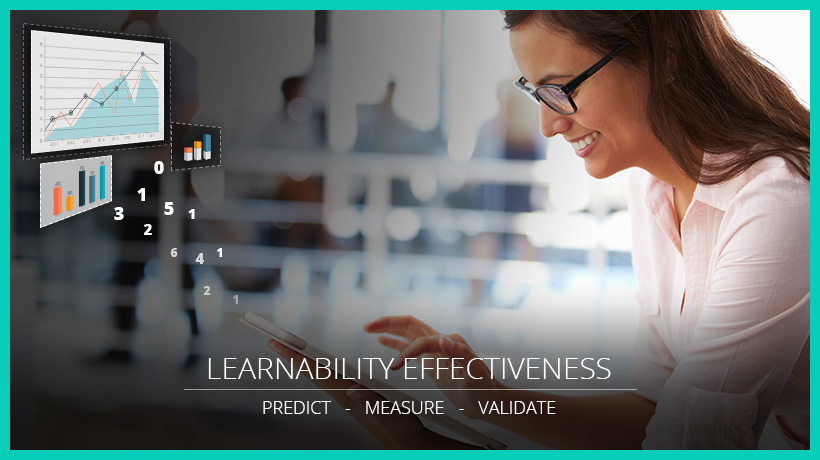
Although the significance of measuring learnability (or learning effectiveness) of online courses is well-established, achieving it is difficult. This article will outline key aspects of our unique framework that you can use to predict, measure, and validate the learnability of online courses.
Why Is Measuring Learning Effectiveness Or Learnability Of Online Courses Vital For Learning And Development Teams?
As we know, to create a positive ROI on your training spend, the biggest enabling factor is the learning effectiveness or learnability of online courses. A better and meaningful user experience increases the stickiness of learning. It also increases the learners’ motivation to take the course leading to higher completion rates.
Once these are in line, you can expect to see an increased application of the learning and this in turn will lead to the desired impact on learner and business.
By evaluating your online courses for learnability, you can predict its impact as well as identify measures to increase it. This will go a long way in achieving a positive ROI on your training spend.
What Are The Challenges That Learning And Development Teams Face In Determining Learnability Of Online Courses (Legacy As Well As New)?
There are several ways that can be adopted to measure learnability of online courses. However, there are not many offerings to pick from that provide an integrated approach which can:
- Begin with the analysis (particularly relevant for existing courses).
- Provide the guidelines that will create the required learnability (for new courses).
- Predict learnability.
- Measure learnability and provide recommendations (and remediation, if required).
- Validate the predictive learnability from users in real time.
- Provide analysis.
- Identify the gaps.
- Provide recommendations on exactly how the identified gap can be bridged.
- Close the loop by recalibrating the existing approach (based on actual user feedback).
- Establish the required learnability.
What Are The Highlights Of Our Framework And How Closely Does It Map To The Wish-List Shown Here To Predict And Measure The Learnability Of Online Courses?
At EI, we have been offering custom learning and performance solutions for over 14 years now. Our learning methodologies not only map to learners’ expectations, but also create the required behavioral change that businesses require.
In Jan’15, we set up a task force to work with a mandate to create a framework that can predict and measure learnability of online courses.
A product of our Innovation Lab, our unique framework is now ready. This enables you to:
-
- Evaluate and measure learnability.
-
- Validate the predictive learnability from users through real time surveys.
-
- Use our analytics to enhance/remediate/reinforce the current approach to meet the required learnability.
Here is a snapshot of our goals and the methodology used:
Our Goals: What We Set Out To Achieve
- Have a predictive methodology to build learning effectiveness and efficacy into training.
- Scientifically measure the courses to diagnose issues that reduce effectiveness and hamper performance.
- Improve learner friendliness and retention, meet the prescribed cognition level, and improve ROI for our customers.
- Provide crucial insights for future learning interventions that can enhance effectiveness of the training curriculum and performance for the learner.
Our Methodology: How We Made It Happen
- We began with research and detailed analysis of data from internal and external sources – issues, feedback, guidelines, best practices, user acceptance test results, and so on.
- Classified all data points into factors that affect learnability.
- Generated measurable parameters from each factor.
- Generated metrics which can be used to further group the parameters based on the scope and goals of learnability. This includes metrics based on task performance, interface usage, content and cognition, design elements, interface and navigation help, and usability.
- Assigned criticality values for all the parameters based on impact and occurrence.
- Generated cumulative learnability index aggregating the values of all the parameters.
- Created development guidelines for cross functional teams to build learnability into courses.
As you will note, our approach is aligned closely to the wish-list we had seen earlier.
- Our approach enables you to apply the learnability guidelines to the new courses and enhance the learnability of legacy courses.
- Additionally, the predictive component can be validated by live users.
- The analytics enables you to recaliberate, as required till you reach the required learnability index.
How Can You Use Our Framework To Measure And Predict Learnability Of Your Online Courses?
You can use our framework for your:
-
- Existing courses.
To evaluate the current learnability and identify measures to enhance it. - New courses.
To predict learnability and more importantly validate with your learners real time.
- Existing courses.
Specifically, the range of our services include:
-
- Creation of parameters for learnability evaluation.
-
- Updating of parameters based on actual evaluation (including bifurcation of parameters to be evaluated on program level and screen level).
-
- Formulation of an implementation strategy to get predictive and diagnostic measurement of learning efficacy using the parameters and guidelines.
-
- Evaluation of courses using formative and summative evaluation with actual users.
What More Is Possible?
-
- Analysis on how to address extended learnability which enables better performance for the learner on the program and on the job: We can monitor a group of users over a period of time and evaluate them based on the metrics. Then we can come up with insights on how to use specific learning interventions to improve performance further.
- Build frameworks on how the learnability metrics and data gathered from users over extended learnability can be used to generate tangible values to improve ROI.
While we have done extensive testing of our framework and the methodology, we are very keen to partner with organizations in this mandate. Do contact me if you would be interested in signing up to measure and predict learnability of your online courses.
This article is one of the three articles on how to measure and predict learnability of online courses. In the next two articles, I will share case studies that will outline how exactly you can predict and measure learnability plus how you can validate the predictive learnability from learners (in real time).



